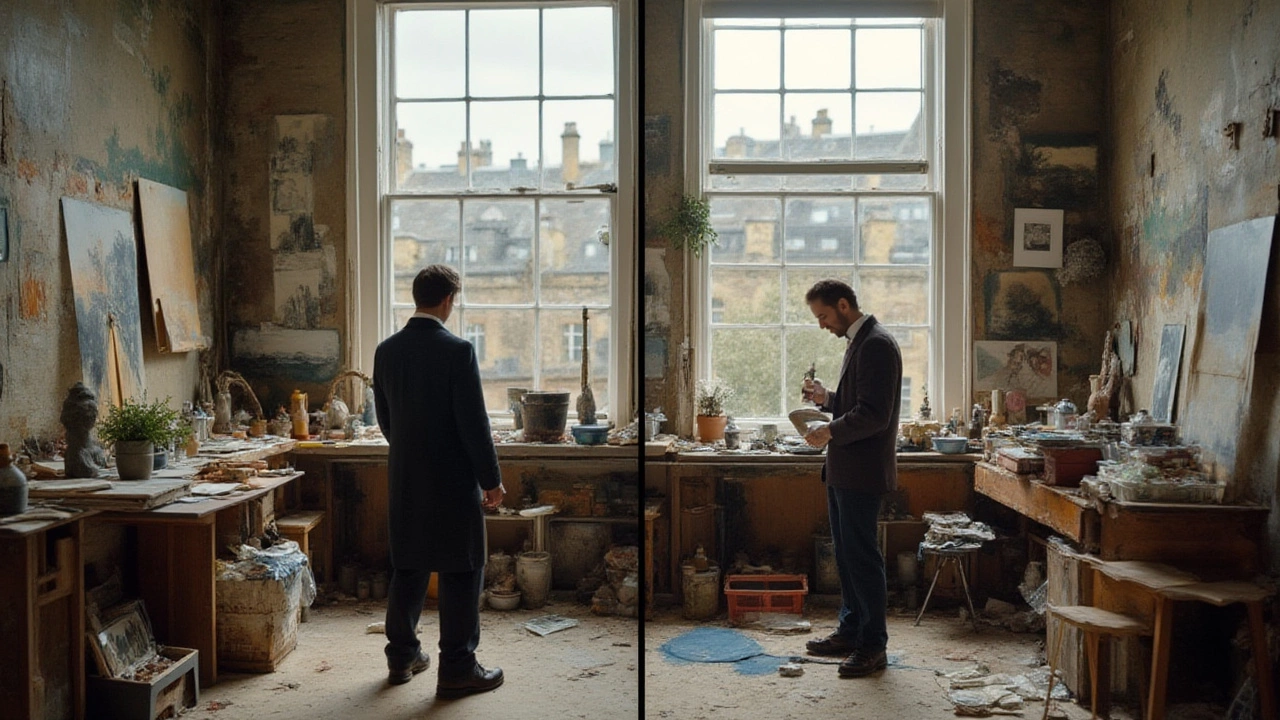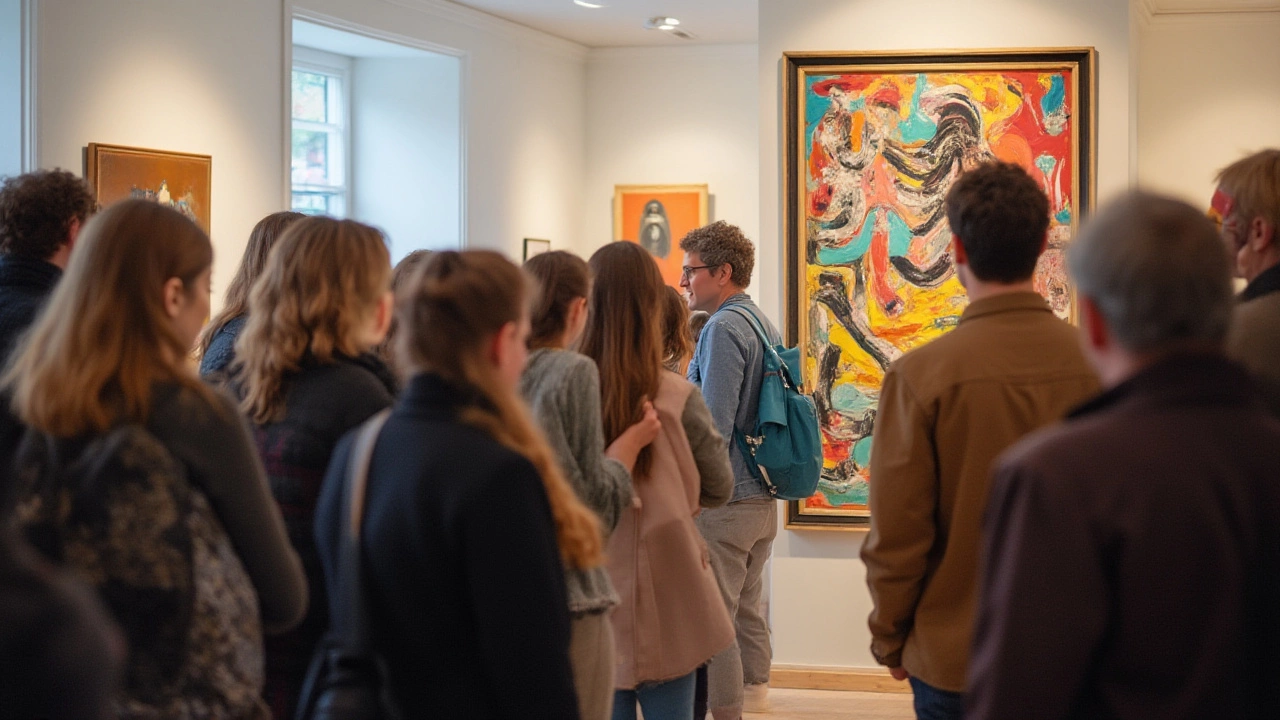Walk into any major museum and you’ll hear people arguing over labels—modern, contemporary, postmodern, abstract, expressionist. No one wants to admit they’re secretly nervous they’ll mix up modern art and contemporary art (honestly, who hasn’t?). It’s the most common art confusion out there. It sounds so nitpicky, yet knowing the difference actually unlocks a secret door to understanding how we got from Monet’s dreamy lilies to the wild installations and digital work flooding galleries now. This divide isn’t just about taste or showing off at parties; it’s about seeing the flow of change and rebellion in art, and how artists respond to the world in totally different ways across decades. Turns out, the gulf between a Picasso and a Damien Hirst is much wider than a few dots and mismatched eyes.
What Exactly Is Modern Art Anyway?
Modern art isn’t just "art that feels new." In fact, by gallery standards, most "modern" works are older than your grandma’s favorite record player. Modern art covers the late 1800s to the mid-20th century, more precisely from around 1860 to 1970. This was art’s big, glitzy breakaway from old-school traditions. Out went the meticulous historical paintings, in came experiments with color, technique, and perspective. The world itself was changing fast—cities grew, photography arrived, wars broke out. Artists refused to just mirror reality; they wanted to shake things up or express how they felt on the inside. Ever looked at a Picasso and thought, what the heck are these shapes? You’re witnessing the heart of modern art—bold moves, strong statements, and a little bit of “take it or leave it.”
Think Monet, with his blurry water lilies, or Van Gogh, slashing his wild yellows and blues onto the canvas. Then came Cubism with Braque and Picasso, literally shattering space and form; Surrealism with Salvador Dalí’s melting clocks and dreamlike visions; Abstract Expressionism with the splashy, chaotic canvases of Jackson Pollock. Modern artists weren't painting pretty pictures for noble patrons. Instead, they wanted to capture the rapid-fire pace and anxiety of their time, inventing new styles seemingly every decade.
Here’s a fun tidbit: the iconic Museum of Modern Art (MoMA) in New York exhibits work from 1880 to about 1980—you won’t find much labeled "contemporary" there. When they say "modern" in MoMA’s halls, it’s a strict definition, not a vague idea of "current."
So, it’s not about when art was made, but that it kickstarted a break with tradition. Modern artists threw out the rulebook, but they still believed art could change the world for the better. They were, in their bones, optimists—even if their paintings looked bizarre at first glance.
Contemporary Art: Art of Right Now
Now, flick the gallery switch forward. Contemporary art is exactly what it sounds like: the art of today—new work, fresh perspectives, unfiltered commentary on life as we live it. It picks up where modern art left off, usually pegged as from the 1970s to now. There’s no single style, medium, or movement. If it’s being made right now, often by living artists, you’re in the territory of contemporary art.
When you walk into a contemporary exhibition, you might see just about anything: LED installations blaring political slogans, hyper-realistic paintings, mixed-media sculptures that crunch when you walk by, performance artists squinting silently in a corner. Anything goes, and that’s kind of the point. It has a freestyle, rebellious spirit—some pieces are subtle, some hit you over the head. Artists take on big issues: climate change, gender, race, technology, social justice. Many contemporary artists skip traditional paint and canvas entirely. Think video art, digital prints, virtual reality, even cryptocurrency art (NFTs, anyone?).
Have you heard of Banksy, the graffiti master who shredded his own painting at an auction in 2018? Or Yayoi Kusama, with her immersive polka-dot rooms that dominate Instagram? Both are classic examples of contemporary artists—provocative, unpredictable, and always part of the wider conversation.
Another key fact: contemporary art often blurs the line between viewer and artist. Don’t be surprised if you’re asked to interact with a piece or become part of the artwork itself. It’s all about direct engagement and shaking loose those old studio stereotypes. Contemporary shows love to challenge: what is art, anyway? Who decides? It’s more about ideas and less about technique.
Sometimes, these artworks sell for jaw-dropping prices. In 2017, Leonardo da Vinci’s Salvator Mundi fetched $450 million, but in the same breath, Jeff Koons' balloon animals and Damien Hirst’s spot paintings have brought in tens of millions, blurring lines between traditional craftsmanship and big-scale spectacle.

The Real Differences: More than Just Dates
People get tripped up because both modern and contemporary art sound like "new" art. The main split? Time period, attitude, and intention. Modern art is old-new—meaning radical ideas from a century or more ago. Contemporary art is now-new—artists currently pushing limits, whether with sculpture, code, or performance. In short, modern art set out to rethink art itself, but contemporary art keeps that rebellion going, often without caring about traditional skills or materials.
Here’s a handy quick-glance table for you:
| Era | Main Styles | Famous Artists | Key Attitude |
|---|---|---|---|
| Modern Art | Impressionism, Cubism, Surrealism, Abstract Expressionism | Claude Monet, Pablo Picasso, Jackson Pollock | Break with tradition, search for deeper meaning |
| Contemporary Art | Conceptual, Installation, Street Art, Digital Art | Banksy, Yayoi Kusama, Jeff Koons | Interactivity, commentary on today’s life |
Another big split? How the public gets involved. Modern art was usually for galleries or collectors, and only rarely strayed outside the frame. Contemporary art busts out—think murals on city streets, Instagram art challenges, or massive installations in abandoned warehouses. It seeks an audience reaction, good or bad.
Love data? A 2021 survey by Art Basel found that 54% of collectors under 40 prioritized contemporary art, while only 18% sought modern works. Seems the future, at least in sales, is squarely contemporary.
Modern art is still influential, fueling university courses, museum wings, and even how today’s artists define themselves. But while a modernist work hangs silently on the wall, a contemporary piece might just tweet you back—or call out your opinions on the spot.
Tips for Navigating Galleries and Talking About Art
Still feel stuck at the difference between the two? Here’s a quick cheat sheet for sorting modern vs contemporary art in the wild. If you want to sound sharp in front of friends—or not get completely lost at a gallery opening—keep these points handy:
- Check the artist’s age or whether they’re still alive. Living artists almost always fall into the contemporary category (with some exceptions for late-career modernists).
- Look for exhibition labels at museums. If it says “Modern” and most artists are from the 1800s to mid-20th century, bingo—it’s modern art. If there are digital media, interactive pieces, or politically driven works by artists born after World War II, odds are it’s contemporary.
- Watch for materials: modern art usually sticks to canvas and paint, sometimes marble or bronze. Contemporary loves video, performance, unconventional items like plastic, supermarket objects, even food.
- If the artwork is asking for your opinion, reaction, or participation, trust your instincts—it's probably contemporary.
- Got questions? Most gallery staffers are downright thrilled to help. Don’t be shy about asking them to explain what’s what.
If you’re into collecting or decorating, clarify first: "modern" in art-speak rarely means modern-day. Many auction houses will tag a 1950s painting as modern and a 2020 digital print as contemporary. Asking for a modern piece might get you a Clyfford Still, not a Jeff Koons bunny.
One more friendly tip: try not to judge. Sometimes people feel anxious that they

